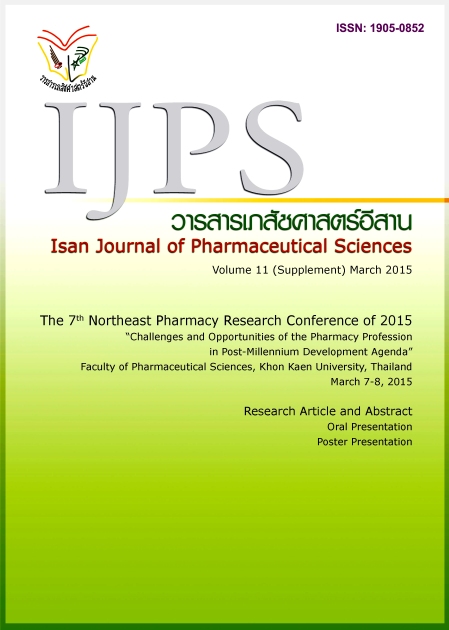Prevalence and Pattern of Antibacterial Use in Upper Respiratory Tract Infections: A Study in Sub-district Health promoting hospitals of Buayai Contracted Unit of Primary Care in Nakhon Ratchasima Province
Main Article Content
Abstract
Introduction: This study has the aim to identify the prevalence and analyze the appearance of antibiotic use which is not corresponding to Upper Respiratory tract Infection (URI) clinical guideline. Materials and Methods: The data from 880 patients with URI Diagnosis and treated in 22 Sub-district Health Promoting Hospital in Buayai Contracted Unit of Primary care was simple random sampling retrospectively collected from electronic health record named HosXP between 1st October 2013 to 30th September 2014 and analyzed the appearance of antibiotic medical record for URI then compared data with FDA’s treatment guideline. Results: According to 880 data of patients, 29.77% (262/880) of antibiotic medical record data was not corresponding to the treatment guideline. This was including (1) Medication use without indication 81.30% (213/262); 185 patients have lower body temperature than 39º, 24 patients have normal physical examination status and 101 patients have symptom no need to take any antibiotic. (2) Untreated indication 4.58% (12/262) and (3) inappropriate medication regimen 14.12% (37/262); 10 patients have Inappropriate medication indication and 27 patients have Inappropriate medication dosage. Conclusions: For the safety of antibiotic use, medication treatment should correspond to URI Clinical guideline for maximum effectiveness. In this study, the most of antibiotic use appearance which is not corresponding to URI clinical guideline is medication use without indication. This affects antibiotic resistance and too much budget of treatment lost problems. Thus the researcher recommends for further study of Medication use without indication factors finding the way to improve more standard quality of drug prescription
Article Details
In the case that some parts are used by others The author must Confirm that obtaining permission to use some of the original authors. And must attach evidence That the permission has been included
References
Apisarnthanarak A, Danchaivijitr S, Kwancharoenporn T, Limsrivili J, Warachan B, Bailey TC, Fraser VJ. (2006). Effectiveness of education and antibiotic- control program in a tertiary care hospital In Thailand. Clin Infect Dis 2006; 42: 768-75.
Buayai Hospital. Annual Report 2013: Department of Community Pharmacy Annual Report, 2013. 56-58.
Chokejindachai W. (2007). Current situation of antimicrobial resistance in Thailand. : A review. Nonthaburi: Health System Research Institute; 2007.
Gonzales R, Steiner JF, Lum A, Barrett PH, Jr. (1999). Decreasing antibiotic use in ambulatory practice: impact of a multidimensional intervention on the treatment of uncomplicated acute bronchitis in adults. JAMA 1999; 281: 1512-9.
Hart CA, Kariuki S. (1998). Antimicrobial resistance in developing countries. BMJ 1998; 317: 647-50.
Jongtrakul P. Antibiotic Smart Use: Rational drug use initiative and implementation. 2nd ed. Bangkok: Aksorngraphic and design; 2011.
Thai Medical Informatics Association 2008. The Top 10 Diseases of Thai people. [2014 Aug 15]. Available from:http://www.tmi.or.th/index.php?option=com_content&view=article&id=288&catid=36:health-information&Itemid=43.
Thamlikitkul V, Apisitwittaya W. (2004). Implementation of clinical practice guidelines for upper respiratory infection in Thailand. Int J Infect Dis 2004; 8: 47-51.
Region health care service system development committee. National Health Security office (NHSO), Thailand (Area9) Nakhon Ratchasima October, 2013. Quality and Outcome Framework (QOF) Fiscal year 2014 Area9 Nakhon Ratchasima. 22-23.


